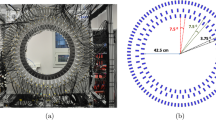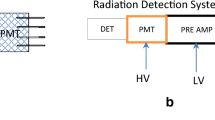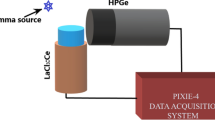Abstract
Currently, plastic (organic) scintillators are using in new type positron emission tomography (PET) devices such as J-PET. But, these type scintillators have low gamma energy detection performance. Therefore, an experimental method was proposed to improve gamma ray energy resolution of an organic scintillation detector composed of a BC-420 type crystal. To do this, a timing spectrometer using constant fraction discrimination method was used. Gamma rays from a 137Cs radioactive source were first detected directly then through the timing method, and the obtained results were compared. The results showed that used method is considerably successful in increasing the energy resolution of this type detector. So, it is believe that the J-PET detection performance will be able to enhance if the proposed method can be used in its electronics.
Similar content being viewed by others
Avoid common mistakes on your manuscript.
INTRODUCTION
Specific gamma ray energy levels of a radioisotope forms a set of sharp lines referred as photopeaks. While the scattered events are considered less important or even as noise or artifacts in certain circumstances, the events associated with primary photopeaks contain the most useful information in imaging. Therefore, in order to accept the desirable primary photons and also to exclude the unwanted scatter counts a window setting usually centered on a photopeak is applied to the pulse-height spectrum.
If one incoming gamma-ray photon interacts with the entire detector within the significant time, the output is taken. Some of the photons can be lost or erroneously registered in the detector as a single interaction with incorrect pulse height and/or pulse time generated with imprecisions if there are multiple interactions by multiple incoming photons [1]. These effects act the detection and energy resolution performance characteristics of a detector negatively. For this reason, a correction or an improvement in the performances is needed.
Pozzi et al. presented the results of the neutron and photon calibration of BC-420 type scintillator [2]. The spectrometric performance of the scintillator for positron lifetime measurement was investigated by Saro et al. [3]. Using BC-420 Smyrski et al. studied to improve the spatial resolution of a plastic scintillator based PET scanner [4]. Mukhopadhyay and Nevada a brief survey of some plastic scintillators including BC-420 for various radiation measurement applications presented [5]. Pion beam test performance of this scintillator was investigated by Ahmad et al. [6].
The timing measurement is utilized for the discrimination of different type of particles. This discrimination is based on the determination of the time of arrival of a pulse generated in a detector by incident particles. One of the most used and effective timing methods is constant fraction discrimination. In this method; the incoming pulse is first split into two with one part delayed by a time equal to the time it takes for the pulse to rise from the constant fraction level to the pulse peak. The other part is inverted and attenuated by a factor to give a pulse. The two are then summed to produce a bipolar pulse [7].
Organic scintillators, i.e., plastic scintillators are sensitive to gamma rays and have a relatively large light output and a short decay time. This makes the materials suited or fast timing measurements [8]. With these characteristics, they preferred to use for a patient body scan in tomography. The Jagiellonian Positron Emission Tomograph (J-PET) is the first PET built from plastic scintillators [9]. Also, Niedzwiecki et al. [9], Gnatek [10], and Moskal et al. [11] used the BC-420 type organic scintillation crystal in their works in relation with J-PET. Although plastic scintillators have better timing performance, they are less efficient for the detection of gamma quanta than inorganic crystals. For this reason, the experimental work here was performed to contribute the energy resolution performance of this type detector.
MATERIALS AND METHODS
A scintillation detector composed of Saint Gobain BC-420 type solid organic scintillator (2 inch diameter and 2 inch length) coupled to a Hamamatsu R1828-01 type photomultiplier tube with magnetic shield case. The scintillator has the second fastest response time (decay constant: 1.5 ns) in the same type scintillator models [12].
A solid point type 137Cs radioactive source of 5 µCi activity (Spectrum Techniques Co.), which it was embedded in mylar disk of diameter of 25 mm and thickness of 5 mm, was used in the study. Passive background reduction was applied to the detector, and the data acquisition time of 100 s was set. The circuit schema of the used spectrometer is given in Fig. 1.
Circuit schema of the used spectrometer. (PS) power supply (ORTEC 556); (PA) preamplifier (ORTEC 113); (A) main amplifier (ORTEC 485); (DA) delay amplifier (ORTEC 427A); (TSCA) timing single channel analyzer (ORTEC 420A); (LG) linear gate (ORTEC 426); (CFD) constant fraction discriminator (ORTEC 584); (D) delay (ORTEC 425A); (TAC) time to amplitude converter (ORTEC 566); (MCA) multichannel analyzer (ORTEC Easy MCA 2k).
In the spectrometer, gamma rays emitted from the source were detected by the detector. The detector signal was sent to the preamplifier and then further amplified by the amplifier. The bipolar output of the amplifier (Fig. 2) was split into two branches in order to gate the photo peak of 137Cs radioisotope. The process was performed by the timing single channel analyzer and a delay amplifier (DA).
The outputs of these devices were sent to the linear gate (LG). Its output was fed into the constant fraction discriminator (CFD). This device generates two timing output signals as follows: the linear gate output is multiplied by the fraction f to correspond to the desired timing fraction of the amplitude. The input waveform is also inverted and delayed for a time greater than the pulse rise time. The pulse rise time is the time between 10 and 90% of signal amplitude (Fig. 3). The delayed and inverted waveforms are then summed to give a pulse [13]. To reject the noise signals, besides, the threshold level was set to 10 mV in the CFD. Timing output signal shape of the CFD is given in Fig. 4.
Schematic representation of a pulse rise time [14].
Timing outputs of the CFD were connected to ‘Start’ and ‘Stop’ inputs of the time to amplitude converter (TAC) which was strobed by the LG output to initiate its read cycle. It generates a timing signal which is proportional to the time interval between its start and stop inputs. To perform the time interval between these inputs 16 ns delay time was applied via the delay device since best result was accepted in distinguishing the signals. The output of the DA was forwarded to multichannel analyzer (MCA) gated by the timing signals from the TAC output. Thus, the MCA records only the energy signals triggered by the timing signals. This is the brief description in the timing branch of the setup called as constant fraction discrimination timing. The detailed description of the method can be found in [13]. This procedure enables us to separation of the photopeak radiations from the non-photopeak ones. Figure 5 shows the logic output signal shape of the TAC.
Obtained results from the setup are given in the next section.
RESULTS AND DISCUSSION
Gamma ray detection performance of one of the fastest organic scintillators (BC-420) of Saint Gobain Co. was tested and further investigated to enhance its photo peak resolution in the present work since the crystal is an alternative choice for PET devices. Gamma ray energy spectrum directly from the 137Cs source was obtained as indicated in Fig. 6.
Although the spectrum resembles roughly a typical 137Cs gamma spectrum, as can be seen from Fig. 6, the photopeak of the radioisotope is not clear. From this, it can be stated that the detector has not enough efficiency to reveal it. For this reason, we gated only the photopeak to show it clearly and to perform the timing process on it. Gated photopeak is given in Fig. 7. In Fig. 8, the source spectrum and the gated photopeak is shown for the comparison of them.
After applying the timing process to the gated photopeak, the spectrum in Fig. 9 was obtained.
In order to recognize the difference between the gated and the timing processed photopeaks a comparison was indicated in Fig. 10.
As a rule, the narrower peak denotes the better energy resolution. It is clear from Fig. 10 that some photopeak signals that are not in the timing interval are vetoed in the process, so the peak was become slimmer. This shows the timing process is quite effective in the discrimination of the non-photopeak signals from the photopeak ones, leading to better energy resolution values. As can be seen from Figs. 7 and 9, photopeak resolution was enhanced from 26.46 to 12.6% with the increment of about double. This is highly satisfying result for the energy resolution improvement.
It is believed that the organic scintillators will be more favored materials especially in medical imaging due to their fast response times. This feature makes them more preferable than the inorganic ones. If the organics couple with the new generation semiconductor devices such as Si photomultipliers, the emerged detection results will contribute to the time resolution of a time of flight PET. Not only the time resolution, in addition to this, but also the enhancement of the energy resolution is more beneficial for distinguishing the different-energy particles to support the imaging results, leading to decreasing the electronic noise in the electronics and increasing the image performance. Any technique for this objective will be more helpful in the development of medical diagnosis.
Consequently, as it is known, PET detectors should have as much as fast response time and high resolution for clear patient detection and monitoring for exact and successful treatment. So, any technique to do this is more useful for the medical community. In this respect, a method was investigated to improve the energy resolution of BC-420 type detector used in the PET devices especially in J-PET. Thus, a contribution in the medical diagnosis was aimed by introducing an experimental technique presented here.
REFERENCES
Chen, C.T. and Kao, C.M., Radiation Detection in SPECT and PET in Radiation Detectors for Medical Imaging, Iwanczyk, J.S., Ed., Boca Raton, FL: CRC Press, 2016.
Pozzi, S.A., Mullens, J.A., and Mihalczo, J.T., Nucl. Instrum. Methods Phys. Res., Sect. A, 2004, vol. 524, p. 92. https://doi.org/10.1016/j.nima.2003.12.036
Saro, M., Petriska, M., and Slugen, V., AIP Conf. Proc., 1996, 2018, vol. 020040, p. 1. https://doi.org/10.1063/1.5048892
Smyrski, J., Alfsa, D., Bednarskia, T., Białasa, P., Czerwińskia, E., Dulskia, K., Gajosa, A., Głowacza, B., Gupta-Sharmaa, N., Gorgolb, M., Jasińskab, B., Kajetanowicza, M., Kamińskaa, D., Korcyla, G., Kowalskic, P., et al., Nucl. Instrum. Methods Phys. Res., Sect. A, 2017, vol. 851, p. 39. https://doi.org/10.1016/j.nima.2017.01.045
https://www.osti.gov/servlets/purl/811396.
Ahmad, S., Bonner, B.E., Gere, W., Mutchler, G.S., Rambo, P., Toshkov, S., Platner, E., Crawford, H.J., and Engelage, J.M., Nucl. Instrum. Methods Phys. Res., Sect. A, 1993, vol. 330, no. 3, p. 416. https://doi.org/10.1016/0168-9002(93)90570-8
Ermis, E.E., Instrum. Exp. Tech., 2021, vol. 64, no. 5, p. 776. https://doi.org/10.1134/S0020441221050183
https://www.crystals.saint-gobain.com/radiation-detection-scintillators/plastic-scintillators.
Niedzwiecki, S., Białas, P., Curceanu, C., Czerwiński, E., Dulski, K., Gajos, A., Głowacz, B., Gorgol, M., Hiesmayr, B.C., Jasińska, B., Kapłon, Ł., Kisielewska-Kamińska, D., Korcyl, G., Kowalski, P., Koziket, T., et al., Acta Phys. Pol., B, 2017, vol. 48, no. 10, p.1567. https://doi.org/10.5506/APhysPolB.48.1567
Gnatek, J.A., PhD Thesis, Krakow: Uniwersytet Jagielloński w Krakowie, 2017.
Moskal, P., Niedźwiecki, S., Bednarski, T., Czerwiński, E., Kapłon, Ł., Kubicz, E., Moskal, I., Pawlik-Niedźwiecka, M., Sharma, N.G., Silarski, M., Zieliński, M., Zoń, N., Białas, P., Gajos, A., Korcyl, G., et al., Nucl. Instrum. Methods Phys. Res., Sect. A, 2014, vol. 764, p. 317. https://doi.org/10.1016/j.nima.2014.07.052
https://www.crystals.saint-gobain.com/products/organic-scintillation-materials.
Knoll, G.F., Radiation Detection and Measurement, New York: Wiley, 2000.
Celiktas, C., Instrum. Sci. Technol., 2006, vol. 34, p. 335. https://doi.org/10.1080/10739140600609458
ACKNOWLEDGMENTS
This work was supported by The Scientific and Technological Research Council of TURKEY under project no. 121F012.
Author information
Authors and Affiliations
Corresponding author
Ethics declarations
The authors declare that they have no conflicts of interest.
Rights and permissions
About this article
Cite this article
Ermis, E.E., Celiktas, C. A Method to Improve Gamma Energy Resolution of BC-420 Type Organic Scintillation Detector. Instrum Exp Tech 65, 376–381 (2022). https://doi.org/10.1134/S0020441222030150
Received:
Revised:
Accepted:
Published:
Issue Date:
DOI: https://doi.org/10.1134/S0020441222030150














